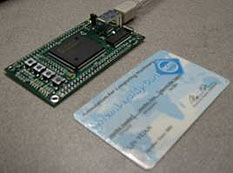News Story
SecureGo Device Makes Online Shopping Safer

SecureGo prototype device next to credit card.
"Our plan is to try to get an agreement with a major online retailer first. If we can do that, others are likely to follow."
Kun Lin, SecureGo Team Member
The root of that fear is the significant potential risk created by sending credit card or other sensitive, personal information "out into the electronic ether," where it could get into the wrong hands. Now a University of Maryland team of engineering students and faculty advisors have devised an ingenious solution that could decrease the risk posed by online commerce and increase the peace of mind of those who engage in it.
The Maryland invention, and the company the students have created to develop and market it, are called SecureGo. Their device is a USB flash drive with encryption capability for secure online transactions. SecureGo would keep critical ID and financial transaction information offline and physically isolated from cyberspace criminals. Rather than entering a credit card number for each online transaction, users could purchase items on the Web using the value programmed into the USB device, somewhat like a prepaid phone card.
It would work like this. SecureGo users would plug their device into whatever computer they are using at the time. SecureGo would prompt the user for a password. Each SecureGo USB device will have a unique ID, and once the user enters her/his password, they can log into any SecureGo-enabled website, use the device ID as their identity, and complete a transaction. The enabled website connects through the computer to SecureGo, verifies the authenticity of the device/request, and transfers the amount from the user's account to the merchant's account.
At the end of the transaction, the device could be unplugged, preventing any possibility that its information or stored value could be accessed by a criminal. If lost or stolen, the device would be password protected. And for further protection, users would be able to set up a cash recovery account into which they could transfer their balance should they lose their SecureGo device.
On Saturday, March 25, team members Kun Lin, a December 2005 graduate in electrical and computer engineering (ECE), and Lin Yuan, a current graduate student in the ECE department, demonstrated the prototype of the SecureGo device at the Oregon Museum of Science and Industry, as part of the Tenth Annual "March Madness for the Mind" event, sponsored by Portland-based Lemelson Foundation and the National Collegiate Inventors and Innovators Alliance (NCIIA). SecureGo was chosen as one of six promising invention teams to present at the NCIIA conference. Their presentation will be recorded for a promotional video.
Last year the NCIIA awarded the Maryland team a $14,837 grant to help them develop the device. The team also won $5000 in May of 2005 when their business plan placed second in the graduate student category of the University of Maryland's annual business plan competition.
The team is looking for investors and also plans to try to interest major retailers, explained team member Kun Lin, who graduated this past December with a B.S. in both computer engineering and finance. "Our plan is to try to get an agreement with a major online retailer first. If we can do that, others are likely to follow."
Published March 28, 2006









